The route through the Northern Areas is planned!
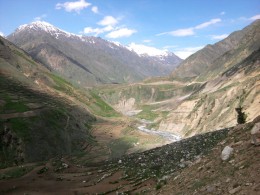 Departing from Islamabad direction north to intercept the legendary Karakorum Highway (KKH), the most hard part of the Silk Route that leads to China crossing the Himalayas (still counted as one of the 5 most dangerous roads in the world [link]). Diversion trough the wild Kaghan Valley to cover in mud our tires and to visit the slope of the glacier. Mysterious Babusar Pass (4173m) and at last again on the KKH all the way until Gilgit, a village so lost in the Himalayan mountains that even Google Maps doesn’t know if to place it in Pakistan or in India.
Departing from Islamabad direction north to intercept the legendary Karakorum Highway (KKH), the most hard part of the Silk Route that leads to China crossing the Himalayas (still counted as one of the 5 most dangerous roads in the world [link]). Diversion trough the wild Kaghan Valley to cover in mud our tires and to visit the slope of the glacier. Mysterious Babusar Pass (4173m) and at last again on the KKH all the way until Gilgit, a village so lost in the Himalayan mountains that even Google Maps doesn’t know if to place it in Pakistan or in India.
Return to be defined.
The first day it’s a bit disappointing: it’s the end of June, cities are ovens and the closest hills are the destination for the massive local tourism. Murree is the most know of this destinations, tiny village overloaded of tourist-with-camera, as soon as we go down of the bike we are surrounded. Duration of our stay: 15 minutes. We keep going north until Nathiagali where we meet the first monkeys and where we stop for lunch. For a roasted chicken they want 6€, in Milan I pay it less. Duration of our stay: 1 hour.
We must go more north…
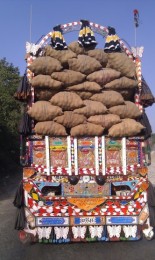 We reach the access to the Karakoram Highway, which proves to be dangerous for real, not so much for the perils of the mountains, but more for the alliance of smog, trucks, traffic, horns, villages blocked by cars, children, animals, very bad road conditions and crazy drivers. I mean, this is all very picturesque: the trucks are colorful, the buses overloaded with people up to the roof
We reach the access to the Karakoram Highway, which proves to be dangerous for real, not so much for the perils of the mountains, but more for the alliance of smog, trucks, traffic, horns, villages blocked by cars, children, animals, very bad road conditions and crazy drivers. I mean, this is all very picturesque: the trucks are colorful, the buses overloaded with people up to the roof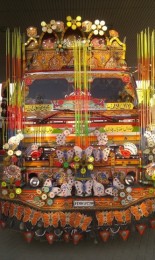 and the small towns full of people, animals and things, but in less than 25km we witness a car crash, we almost get involved in head-on collision ourselves and we get “moved out of the way” from a huge bus. The deadly overtake technique denotes a complete commitment to Allah’s will… it’s not rare to see cars that overtake other cars that are overtaking a truck.
and the small towns full of people, animals and things, but in less than 25km we witness a car crash, we almost get involved in head-on collision ourselves and we get “moved out of the way” from a huge bus. The deadly overtake technique denotes a complete commitment to Allah’s will… it’s not rare to see cars that overtake other cars that are overtaking a truck.
We leave unharmed the KKH to enter in the Kaghan Valley, it’s sunset and, tired, we finally turn off the motorbike at the Balakot PTDC (the hotels of the government). The manager welcomes us in the best way: he starts by offering us a room for half of the price and ends allowing us to put the tent in the garden for free… from now on, by word of mouth, we become official (and not paying) guests of all the PTDC of all Pakistan!
But where is this wild North that we are looking for? Could it be an illusion?
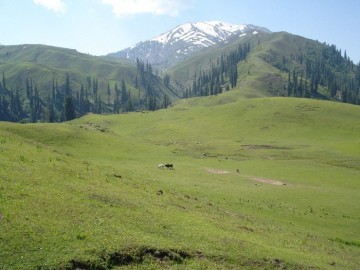 We keep riding northward in the Kaghan Valley, diverting up on a rocky off-road that climbs up to 2300m to Shogran. Even this village is extremely touristic, but the landscape of forests and bright green meadows starts to show the astonishing beauty of this land. The situation here shows all its contrasts: rural villages, isolated for most of the year with farming and fire as only source of sustenance, during the summer become shiny and consumeristic fairs. At dusk the concert of generators that start one after the other cover the sounds of the night; the smell of diesel and the lights of the stands attract swarms of tourists from the cities eager of breathe “mountain air” and spend their money in “genuine” products of their land. Like homemade honey, poured directly from a bucket, with pieces of comb still inside (always the same ones) completely soaked in a sweet and thick fluid… mostly made of sugar! Or the local products made from grandma Nestlè, packed one by one in many layers
We keep riding northward in the Kaghan Valley, diverting up on a rocky off-road that climbs up to 2300m to Shogran. Even this village is extremely touristic, but the landscape of forests and bright green meadows starts to show the astonishing beauty of this land. The situation here shows all its contrasts: rural villages, isolated for most of the year with farming and fire as only source of sustenance, during the summer become shiny and consumeristic fairs. At dusk the concert of generators that start one after the other cover the sounds of the night; the smell of diesel and the lights of the stands attract swarms of tourists from the cities eager of breathe “mountain air” and spend their money in “genuine” products of their land. Like homemade honey, poured directly from a bucket, with pieces of comb still inside (always the same ones) completely soaked in a sweet and thick fluid… mostly made of sugar! Or the local products made from grandma Nestlè, packed one by one in many layers  so that they can give more colors to the ordinarily green mountain.
so that they can give more colors to the ordinarily green mountain.
The figure of the typical Pakistani starts to be outlined: the locals are authentic, welcoming, with an open mind, you can recognize them from the traditional clothes (the Shalwar Kameez for men; women are not very seen); while rude, clumsy and childish are the rich Punjabi tourists (easily recognizable from the shorts, polo shirt, reflex and cow-boy hat). This hordes are mostly in groups of 3 or 4 family men and they all come from the same place: Lahore, in the Pakistani Punjab. Obviously we’ve found some exceptions, like our new, just met, super friends from Lahore: Usman, Rashid and Raaz.
We set our tent in a lawn, next to the hut of a hotel cook (we’ll have breakfast with him every morning), and for a couple of days we alternate between relax and hikes on the meadows up to the glacier.
The morning of the third day the road is calling us, we say goodbye to everyone, we jump on the bike again… but halfway of the steep and muddy slope to go out of the village a wet water pipe makes us loose grip completely in the rear tire; with the gas open and the road muddy and wet there is no time to react: instantaneous 180° spin scraping the side against rocks and mud. The side pannier made of (fake) aluminum is literally torn to shreds, the pannier holder made of (real) steel is bended and half-wrecked and my knee – always the same one – makes me scream. Third fall, all on the left side (like in Turkey), where ligaments and meniscus already gave up long time ago.
Low in spirits, everything is called into question; the knee is swollen, the bike cannot be ridden without a pannier and the days left on the visa are numbered. Go back to Islamabad? But how? Before giving up in despair we can make another, optimistic, to say the least, attempt: maybe in Balakot (dusty town with one petrol pump and one bridge) we’ll find who can straighten up our pannier holder and who can build a custom-made metal pannier with the right frames, the lot within a day’s time and what’s more, it’s Friday, sabbath-day…
We decide to go back to Balakot with the public transportation: I limp, the rests of the panier are held together with a rope and the frame is completely bended. The initial embarrassment for our miserable condition is going to disappear very soon, when a man with a huge piece of rusty metal sheet gets on the bus and we relax a little bit more.
At the market everything is desolately closed, but we start to talk with the people and a good support team starts to grow around us. Despite the language things start to move, we keep walking from a almost-open shop to another one, and in no time, while a deaf mute with a blowtorch 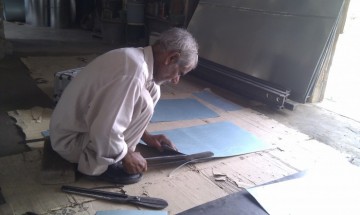 fix our frame in the middle of the street, a old man with the cataract found in the darkness of a half-closed shutter, build us a custom-made steel box for less than 10€. It’s almost done, in the meanwhile I walk around in the hardware stores area, searching in a pile of junk of a scrap dealer I buy a piece of rusty iron, with some imagination, a piece of chalk, and a blacksmith in a flash it becomes 2 L-stands with holes that complete the last piece of our puzzle. Mission complete, time needed: few hours.
fix our frame in the middle of the street, a old man with the cataract found in the darkness of a half-closed shutter, build us a custom-made steel box for less than 10€. It’s almost done, in the meanwhile I walk around in the hardware stores area, searching in a pile of junk of a scrap dealer I buy a piece of rusty iron, with some imagination, a piece of chalk, and a blacksmith in a flash it becomes 2 L-stands with holes that complete the last piece of our puzzle. Mission complete, time needed: few hours.
This Treasure Hunt at the Balakot Bazar brings new enthusiasm; the same problem in Europe would have been solved either with a lot of money or with a lot of time. This sharp victory will be remembered and celebrated in the years to come. We go back to the PTDC for a lavish deserved dinner, that we enjoy like in the commercial of the Amaro Montenegro… for all the non-Italians who don’t have a culture in italian television or spirits, here is the link to the commercial on youtube. More… Hide…
The Guide, young man, refined but of humble origins: he saw us on the bus -he guessed we were full of problems- and he offered us to be our guide and translator in the bazaar; not that he could speak english, but he knew the secret of patience.
The Deaf Mute with the BlowTorch, whom we tought was the village idiot whereas he was the only one who understand everything from the beginning while all the others where still shaking their heads; he basically had to wrestle the frame out of our hands and fix it in front of us (even in Iran we had the same experience: with the deaf mute there is understanding)
The Old Man with the Cataract, it would be worth to meet him: old, blind, senile, with evident Parkinson tremors, without a table or a light in his workshop, only a pair of scissors and a hammer; but he uses his feet like hands, and with skills, method and precision he accomplished his job positively, without taking not even one measurament! No assembly line robot could get even close to his efficiency.
We go back to take our bike, in the meantime our contacts between the manager of the valley grow and we are welcomed guest even in Shogran, where, up to now, we know almost everybody. We are welcomed back and especially we are adopted by a nice couple from Lahore, Ali and his wife, that assisted us at the time of our fall and who where worried for us.
The bike is ready, but me? I limp and I’m frightened. I’m not sure if I will ever be able to find what I’m looking for even if I continue North… but if I find it, will I be able to face it?
It’s now time to leave hearth and home, in the next and last part of this adventure we’ll finally leave behind the tourists playing with their reflex and we’ll penetrate inside the glacier, there where the road ends. Yet new traps are waiting for us, and, to Gilgit we’ll never reach…

Raddrizzare un tubo in acciaio, costruire una valigia in alluminio e fare due staffe per fissare il tutto? A Milano ci mettevi due settimane! Fantastico e paradossale che per costruire cose da zero sia molto più facile farlo in uno sperduto paesino del Pakistan che in una metropoli europea. Ma è anche logico in effetti, noi abbiamo tutto pronto ormai, loro spesso devono costruirsi le cose di cui hanno bisogno.
Guarda, ora siamo a Pushkar, e io passo le mattinate ad osservare l’uomo con la fiamma ossidrica (la sua officina è un armadio di metallo sul ciglio della strada).
Che mestiere affascinante… quando avrò una casa io lavorerò il ferro!
Scommettiamo?